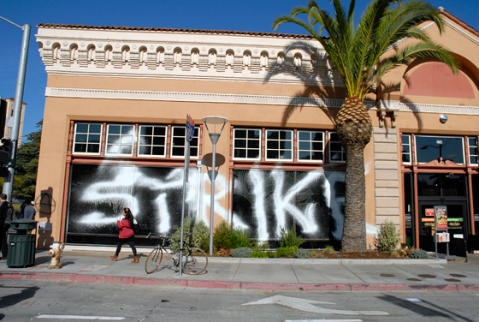Lost in the Fog: Dead Ends and Potentials of the Occupy Movement
December 4, 2011
The following text comprises a presentation and analysis of the Occupy movement in the United States, by the Lost Children’s School of Cartography. The text was used as a basis for an event on the Occupy movement, that took place at the Skaramanga occupation in Athens, on November 25th, 2011. The brochure published for the event, including this text in Greek, along with the video screened on the night are available here.
Lost in the Fog: Dead Ends and Potentials of the Occupy Movement
Introduction
So what do you make of this Occupy movement in America? Of course it is the news that everyone wants to hear about. Al Jazeera claimed shortly after the encampment near Wall Street was founded that the Occupy movement in America was facing a mainstream “media blackout.” But in reality, it seemed that nearly every media source was dedicating coverage nationally and internationally. Despite all the press, if one added up the total number of participants in the fledgling occupations throughout America at that time, he would end up with far less than the total number of demonstrators at a general strike in Athens, or a single American anti-war demonstration from 2004.
This alone should serve as a cause for skepticism, although perhaps it is only predictable that in America, of all places, a social movement would arise firstly as the mere spectacle of revolt. After all, its initial coordinators intended from its inception that the Occupy movement of America be a copy of a copy. The genuine, spontaneous, and seemingly unstoppable surge of rage–the insurrection–in the Arab world had already been watered down into the pacifist indignados movement of Europe. Next the American radicals who called for an occupation of Wall Street would try to copy-and-paste the indignados movement to America by sprinkling a tactic–occupation–on what they hoped would prove grounds fertile enough to grow a movement.
That movement now seems to be swept up in its own momentum, and every day there are new developments in what seems to be a genuinely unpredictable and leaderless social reaction. While the occupations were perhaps first populated by the same cliques of activists who had championed the previous failed American social movements, the encampments and demonstrations have grown because they have attracted the self-identified American “middle class.” As American society comes under further blows of the so-called “crisis” of capitalism, the illusion of middle class comfort dissipates, revealing its previously hidden, but now more apparent, dispossession. The Occupy movement is an opportunity for the middle class to protest the “unfairness” of their proletarianization. In part thanks to widespread disillusionment with political representatives, previously non-activist citizens are suddenly eager to participate in an activist social movement. Paradoxically, the brightest hope we can find in this situation is also the grimmest fact: the increasingly dire economic situation is not turning around, and life will not go back to the way it once was. It is precisely because the movement for a preservation of the illusory American dream is doomed to fail that the Occupy movement has the potential to supersede itself.
Of course, regardless of its active decomposition, the middle class carries its values into the movement–the ideological values of the good citizen. One could characterize the Occupy movement as a citizens’ movement for the survival of capitalist democracy in a moment ripe with potentials for true rupture. Here, self-described radicals, anti-authoritarians and in some cases even anarchists may play the most critical but hidden roles in recuperation, if in their well-intentioned attempt to “build the new world in the shell of the old” they actually succeed at protecting the core of the old world in the shell of the new. (We will elaborate on this in a moment.)
But there is also a beautiful discord within the situation. The Occupy movement can hardly be summed up by any particular ideological stance, and its greatest potentials spring from its chaotic features and resistance to definition. Anarchists who have stubbornly refused any participation in what they have disregarded as merely a bourgeois movement have safeguarded their identities as the most radical of all at the cost of guaranteeing their own irrelevancy in the developing situation. In order to move the Occupy movement in the direction of genuine upheaval, anarchists must participate to cause sustained and intensifying disruption and destruction of the apparatuses of capital in order to make this movement a threat to capitalism, aiming to outflank the state by generalizing these tactics. We will also explore the developments in this direction so far as well as some future potentials.
